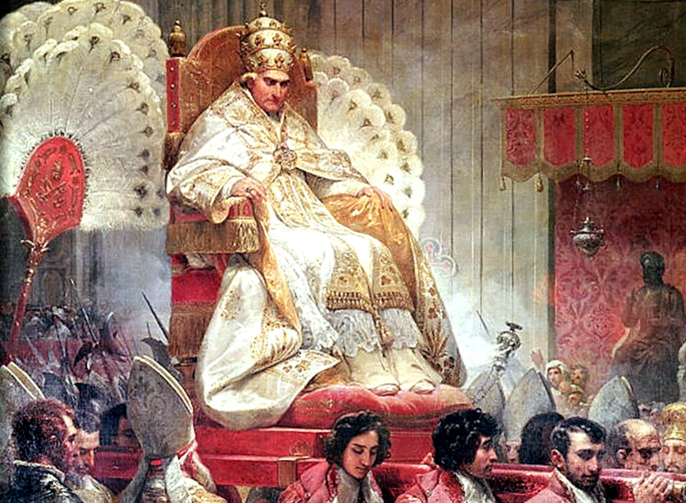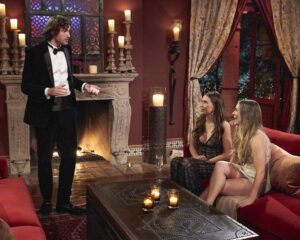In 2000, Thomas Reese, S.J., then the editor in chief of America, asked me to write an article on how the church differed between the first millennium and the second. I found the assignment easy because one difference stood out like no other: a new centrality of the popes in the church of the second millennium. In that millennium, the popes came to wield an authority and play a role incomparably greater than in the first.
I called this phenomenon the papalization of the church. I apologized for the neologism, but I felt then, and still feel now, that it so neatly hit the nail on the head that its novelty was justified. The church in the West became the papal church, and Catholics became papists. The development signified a more exclusively top-down and hierarchical mode of church, in contrast to the more synodal and collegial earlier mode. It went unchallenged until recent times, most notably by the Second Vatican Council and Pope Francis.
In the second millennium, the church in the West became the papal church, and Catholics became papists.
The causes of the papalization process were multiple, complex and inextricably entangled with the general development of Western social, political and cultural history. Even such seemingly unrelated phenomena as the invention of radio, television and jet travel played a role.
Nonetheless, some of the most important and symptomatic steps in the process were the results of direct actions taken by the popes themselves. The popes were in fact the single most important agents in the papalization process. I describe their actions as self-conferred upgrades. Three such papal actions in that regard are the most obvious and the most symptomatic of the great change underway: the claim to have the power to depose secular rulers, the claim to be vicar of Christ and the claim to possess infallible teaching authority.
The authority to depose rulers
Early in the history of the church, popes argued that their authority was greater than that of secular rulers because it was a spiritual authority. The spiritual was in principle superior to the temporal. Yet no matter how often popes or bishops might invoke that principle as justification for a superior authority, it usually did not carry the day, in part because kings and emperors also argued that their authority was spiritual.
In any case, the matter lay unresolved until the tumultuous pontificate of Pope Gregory VII (r. 1073-85) and the great conflict known as the Investiture Controversy. That conflict was almost the inevitable outcome of a feature of an intimately related phenomenon known as the Gregorian Reform, which had originated earlier in the mid-11th century with a small group of Italian clerics intent on ensuring worthy candidates for the episcopacy. To achieve that goal, the reform tried to restrict the authority of secular rulers to choose prelates.
Pope Gregory took that aspect of the reform to its ultimate limits by twice deposing Emperor Henry IV of the Holy Roman Empire; these actions ended in bitter conflicts that finally drove the pope into exile from Rome and led to the worst sack of the city in its history. Despite the pope’s defeat, his successors subscribed to the claim and began deposing kings and emperors. These measures reached a climax in 1570 with the deposition of Queen Elizabeth I of England by Pope Pius V (r. 1566-72), an action that badly backfired. As almost a corollary to the right to depose rulers, popes also claimed the right to adjudicate political disputes among rulers.
Gregory had based his claim on a sprawling ideology that he articulated in a document known as the “Dictatus Papae” (“Memorandum About the Pope”), composed in 1075. Although never promulgated, it revealed a mindset that, while it presumed to be based on tradition, was a radical departure from it. Here are three of its 27 headings: “That the pope may be judged by no one”; “That the pope is the only one whose feet may be kissed by princes”; and, most important, “The pope has the authority to depose emperors.” Although Gregory tried to find precedents for that last claim, he was unconvincing. His action against Emperor Henry IV constituted a major self-conferred papal upgrade and gave subsequent popes an increased sense of the deference owed them in the church.
As almost a corollary to the right to depose rulers, popes also claimed the right to adjudicate political disputes among rulers.
Vicar of Christ
Pope Gregory VII consistently, almost obsessively, referred to himself as the vicar of Peter; in that regard, he was in line with the mainline tradition that originated with Pope Leo I (r. 440-61). Gregory saw himself invested with all the authority Christ had conferred upon the prince of the Apostles. But in so doing, he imbued Peter with an authority new in its force and in its far-reaching scope, a force and scope few of his contemporaries accepted. Yet even with Gregory’s extreme interpretation, it never occurred to him to take the momentous step of referring to himself as vicar of Christ.
Although the title Vicar of Christ appears in the tradition in the early centuries, it was not common, nor was it firmly affixed to any specific office in the church. It sometimes referred to bishops and on occasion even to the bishop of Rome, yet it gained no prominence. This is true even though the Roman synod of 495 called Pope Gelasius (r. 492-96) Vicar of Christ. The term simply did not catch on.
In the 12th century, theologians and canonists brought the term into a certain restricted prominence, but they did not consistently attach it to the papal office. That changed dramatically with Pope Innocent III (r. 1198-1216), who claimed the title for himself. He must be given credit for this major upgrade. Beginning with him, the title came into currency and became standard. The move from vicar of Peter to vicar of Christ was not simply new window dressing for the papal office, but a major enhancement of its dignity. It seemed to imbue the papacy almost with divinity. Pope Innocent conferred this upgrade upon himself and, as an almost inevitable consequence, upon his successors for the centuries to come.
It can be argued that in “Pastor Aeternus” the First Vatican Council confirmed the authority the pope had already claimed for himself.
Infallible teacher of doctrine
As Catholics know, the First Vatican Council (1869-70) defined that the pope was infallible when under certain conditions he taught that a teaching was of divine and apostolic origin and thus an essential element in the deposit of faith. Some Catholics inside and outside the council challenged the definition, but to no avail. “Pastor Aeternus,” the council’s decree on papal primacy and infallibility, carried the day.
Rarely do we hear much about Pope Pius IX’s (r. 1846-78) role in the matter; indeed, when the council opened he seemed rather indifferent to the possibility of a definition of infallibility. As pressure within the council mounted in favor of one, he began to promote it, sometimes openly, sometimes covertly, but ever more unrelentingly. He gave every encouragement to the prelates pressing for the definition and did just the opposite for those opposing it. Nonetheless, we cannot on that score lay credit for the passage of the definition exclusively at his door. Others in the council were powerfully at work in that regard.
Yet another action by Pius allows us to see infallibility as a papal self-conferred upgrade. In 1864, well before the council opened, Pius, in the apostolic constitution “Ineffabilis Deus,” infallibly defined as a divinely revealed dogma that the Blessed Virgin Mary was immaculately conceived. No pope had ever before defined a dogma. In this way, the pope anticipated the council’s definition by six years. It can be argued, therefore, that in “Pastor Aeternus” the council confirmed the authority the pope had already claimed for himself.
As early as the patristic era, the axiom that “the Roman church does not err” had taken hold, especially in the West.
It is true that beginning in 1849, Pius consulted the bishops of the world about defining the Immaculate Conception, but nowhere in “Ineffabilis Deus” is there any mention of such a consultation or any suggestion that the pope’s action was in any way influenced by it. According to “Ineffabilis Deus,” the definition was a papal action pure and simple, with the consultation seemingly irrelevant. Six years later, “Pastor Aeternus” left no doubt on the matter when it pointedly specified that papal infallibility had no dependency on “the consent of the church.” Pius himself was the author of that clarifying clause and was responsible for its insertion in the decree. Critics of the expression claimed that it severed the head of the church from the body, as if the faith of the church at large were irrelevant.
The dogma of infallibility did not come hurtling out of nowhere. The peculiar political conditions in Europe in the 19th century after the French Revolution gave rise to the powerful ultramontane movement, in which papal infallibility consistently lurked beneath the surface as an important plank in its program; but there was a long-standing doctrinal tradition that arguably supported it. As early as the patristic era, the axiom that “the Roman church does not err” had taken hold, especially in the West. The axiom meant that the Roman church, through the person of its bishop, could be counted on to come down on the orthodox side in major disputes over doctrine.
The inerrancy of the Roman church differed, however, from papal infallibility in a subtle but crucial way. Inerrancy rested on the principle that the pope acted as judge, as the final court of appeal in disputed doctrinal questions. He was thus a witness to the faith of the church but not a proactive and seemingly independent teacher of it.
The difference between judge and teacher had radical implications. By the early years of the 20th century, the offices of the Roman Curia began issuing instructions at a newly regular pace. Moreover, popes themselves began issuing encyclicals and similar documents with much greater frequency than before and attributing to them ever greater authority. Theologians in turn began more explicitly and frequently basing their arguments on papal documents rather than on a wider range of authoritative sources.
In our own day, Pope Francis has tried to carry forward the teaching of Vatican II by stressing the legitimacy of “consulting the faithful in matters of doctrine.”
Hierarchy over collegiality
This papal self-conferred upgrade was the culmination of the papalization of the church, which reached its most robust form in the first half of the 20th century. By then it had sidelined and almost obliterated the synodal and collegial aspect of the church’s structure in favor of the hierarchical, top-down aspect. This development was not simply an interesting historical fact but a force that deeply affected how we think and behave as Catholics.
Just after the middle of the last century came Vatican II. In its deliberations and decrees, the council consistently and sometimes valiantly tried to redress the balance between the authority of the center and the periphery by empowering the latter. It did so in several ways, most notably by teaching the collegial relationship between the college of bishops and the bishop of Rome and its description of the church as “the people of God.”
In our own day, Pope Francis has tried to carry forward the council’s teaching by stressing the legitimacy of “consulting the faithful in matters of doctrine.” He has given this principle practical force in the synodal process he has set in motion. The process is essentially collegial and, as Francis specifies it, radically rooted in the teaching that the church is the whole people of God.
Francis has meanwhile changed the curia’s style from authoritarian to collegial. Curial officials now ask bishops how they can help them rather than telling them what to do. The change implicitly empowers the periphery. In his recent and remarkable apostolic constitution on the reform of the curia, “Praedicate Evangelium” (“Preach the Gospel”), Francis gives institutional form to this and similar changes—signs he seeks to reverse the papalization trajectory of recent history.



